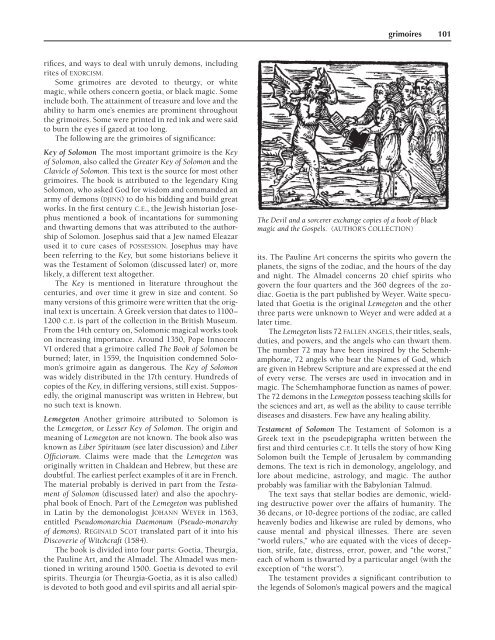The Encyclopedia Of Demons And Demonology
The Encyclopedia Of Demons And Demonology
The Encyclopedia Of Demons And Demonology
Create successful ePaper yourself
Turn your PDF publications into a flip-book with our unique Google optimized e-Paper software.
grimoires 101<br />
rifices, and ways to deal with unruly demons, including<br />
rites of EXORCISM.<br />
Some grimoires are devoted to theurgy, or white<br />
magic, while others concern goetia, or black magic. Some<br />
include both. <strong>The</strong> attainment of treasure and love and the<br />
ability to harm one’s enemies are prominent throughout<br />
the grimoires. Some were printed in red ink and were said<br />
to burn the eyes if gazed at too long.<br />
<strong>The</strong> following are the grimoires of significance:<br />
<strong>The</strong> Devil and a sorcerer exchange copies of a book of black<br />
magic and the Gospels. (AUTHOR’S COLLECTION)<br />
Key of Solomon <strong>The</strong> most important grimoire is the Key<br />
of Solomon, also called the Greater Key of Solomon and the<br />
Clavicle of Solomon. This text is the source for most other<br />
grimoires. <strong>The</strong> book is attributed to the legendary King<br />
Solomon, who asked God for wisdom and commanded an<br />
army of demons (DJINN) to do his bidding and build great<br />
works. In the first century C.E., the Jewish historian Josephus<br />
mentioned a book of incantations for summoning<br />
and thwarting demons that was attributed to the authorship<br />
of Solomon. Josephus said that a Jew named Eleazar<br />
used it to cure cases of POSSESSION. Josephus may have<br />
been referring to the Key, but some historians believe it<br />
was the Testament of Solomon (discussed later) or, more<br />
likely, a different text altogether.<br />
<strong>The</strong> Key is mentioned in literature throughout the<br />
centuries, and over time it grew in size and content. So<br />
many versions of this grimoire were written that the original<br />
text is uncertain. A Greek version that dates to 1100–<br />
1200 C.E. is part of the collection in the British Museum.<br />
From the 14th century on, Solomonic magical works took<br />
on increasing importance. Around 1350, Pope Innocent<br />
VI ordered that a grimoire called <strong>The</strong> Book of Solomon be<br />
burned; later, in 1559, the Inquisition condemned Solomon’s<br />
grimoire again as dangerous. <strong>The</strong> Key of Solomon<br />
was widely distributed in the 17th century. Hundreds of<br />
copies of the Key, in differing versions, still exist. Supposedly,<br />
the original manuscript was written in Hebrew, but<br />
no such text is known.<br />
Lemegeton Another grimoire attributed to Solomon is<br />
the Lemegeton, or Lesser Key of Solomon. <strong>The</strong> origin and<br />
meaning of Lemegeton are not known. <strong>The</strong> book also was<br />
known as Liber Spirituum (see later discussion) and Liber<br />
<strong>Of</strong>ficiorum. Claims were made that the Lemegeton was<br />
originally written in Chaldean and Hebrew, but these are<br />
doubtful. <strong>The</strong> earliest perfect examples of it are in French.<br />
<strong>The</strong> material probably is derived in part from the Testament<br />
of Solomon (discussed later) and also the apochryphal<br />
book of Enoch. Part of the Lemegeton was published<br />
in Latin by the demonologist JOHANN WEYER in 1563,<br />
entitled Pseudomonarchia Daemonum (Pseudo- monarchy<br />
of demons). REGINALD SCOT translated part of it into his<br />
Discoverie of Witchcraft (1584).<br />
<strong>The</strong> book is divided into four parts: Goetia, <strong>The</strong>urgia,<br />
the Pauline Art, and the Almadel. <strong>The</strong> Almadel was mentioned<br />
in writing around 1500. Goetia is devoted to evil<br />
spirits. <strong>The</strong>urgia (or <strong>The</strong>urgia-Goetia, as it is also called)<br />
is devoted to both good and evil spirits and all aerial spirits.<br />
<strong>The</strong> Pauline Art concerns the spirits who govern the<br />
planets, the signs of the zodiac, and the hours of the day<br />
and night. <strong>The</strong> Almadel concerns 20 chief spirits who<br />
govern the four quarters and the 360 degrees of the zodiac.<br />
Goetia is the part published by Weyer. Waite speculated<br />
that Goetia is the original Lemegeton and the other<br />
three parts were unknown to Weyer and were added at a<br />
later time.<br />
<strong>The</strong> Lemegeton lists 72 FALLEN ANGELS, their titles, seals,<br />
duties, and powers, and the angels who can thwart them.<br />
<strong>The</strong> number 72 may have been inspired by the Schemhamphorae,<br />
72 angels who bear the Names of God, which<br />
are given in Hebrew Scripture and are expressed at the end<br />
of every verse. <strong>The</strong> verses are used in invocation and in<br />
magic. <strong>The</strong> Schemhamphorae function as names of power.<br />
<strong>The</strong> 72 demons in the Lemegeton possess teaching skills for<br />
the sciences and art, as well as the ability to cause terrible<br />
diseases and disasters. Few have any healing ability.<br />
Testament of Solomon <strong>The</strong> Testament of Solomon is a<br />
Greek text in the pseudepigrapha written between the<br />
first and third centuries C.E. It tells the story of how King<br />
Solomon built the Temple of Jerusalem by commanding<br />
demons. <strong>The</strong> text is rich in demonology, angelology, and<br />
lore about medicine, astrology, and magic. <strong>The</strong> author<br />
probably was familiar with the Babylonian Talmud.<br />
<strong>The</strong> text says that stellar bodies are demonic, wielding<br />
destructive power over the affairs of humanity. <strong>The</strong><br />
36 decans, or 10-degree portions of the zodiac, are called<br />
heavenly bodies and likewise are ruled by demons, who<br />
cause mental and physical illnesses. <strong>The</strong>re are seven<br />
“world rulers,” who are equated with the vices of deception,<br />
strife, fate, distress, error, power, and “the worst,”<br />
each of whom is thwarted by a particular angel (with the<br />
exception of “the worst”).<br />
<strong>The</strong> testament provides a significant contribution to<br />
the legends of Solomon’s magical powers and the magical












